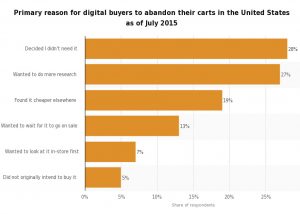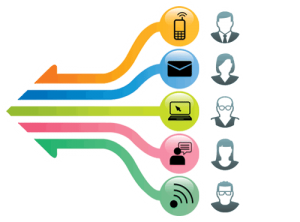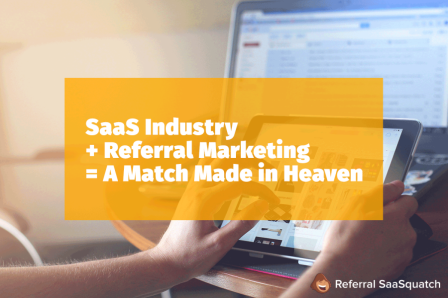
Not all forms of marketing are created equal. Certain channels for SaaS can build a flywheel effect for your company where they organically add new customers every month for your service. SaaS referral marketing is one of these organic channels that we’ve seen Dropbox, Evernote and Typeform use to build profitable marketing campaigns.
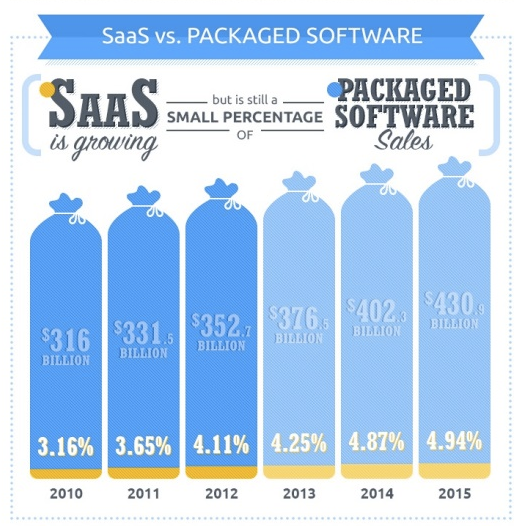
(Source)
There’s good reason for making this point. SaaS products tend to have a lot of features that would typically send marketers running. On the one hand, SaaS relies on a subscription model, requiring that customer loyalty be fostered and maintained indefinitely. The broader market, despite growing as indicated in the graph above, is also in a near-permanent state of flux, with the need for new features and functionalities to be constantly and consistently added.
In this guide, we’re going to provide you with a blueprint for organizing and implementing a robust referral program for your SaaS company. The real truth about referral marketing is that it’s actually one of the more effective channels, and the opportunities for marketers willing to take the plunge are significant.
Understanding “traction channels”
The term “traction channel” comes from a recently-published book called Traction written by Gabriel Weinberg and Justin Mares. In a business context, traction refers to the level to which a company is gaining and keeping new customers. From the perspective of SaaS, a high-traction enterprise is one that has a high client-acquisition rate and a low churn rate.
The word traction itself is defined as the grip of a moving object, such as a tyre, on a surface. When you think of it in terms of business, it’s almost as though a company’s promotional channels are embedding themselves into the market. The level to which each channel can “grip” the market, pulling new customers in and fuelling growth, is a measure of that channel’s traction.
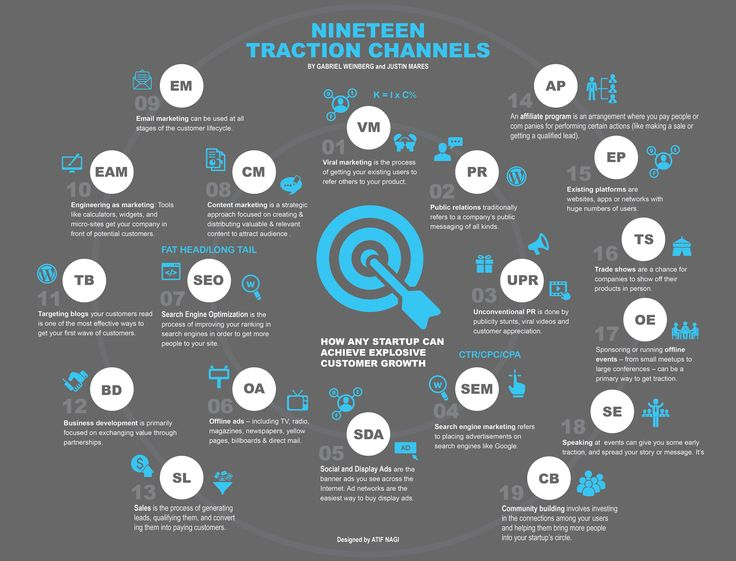
(Source)
So how does this relate to a guide about referral marketing? One of the important points that both Weinberg and Mares make in their book is that most young enterprises, and even certain established ones, only need one successful traction channel to achieve high levels of growth. The billionaire Paypal founder Peter Thiel puts it eloquently:
[You] probably won’t have a bunch of equally good distribution strategies. Engineers frequently fall victim to this because they do not understand distribution. Since they don’t know what works, and haven’t thought about it, they try some sales, BD, advertising, and viral marketing — everything but the kitchen sink.
That is a really bad idea. It is very likely that one channel is optimal. Most businesses actually get zero distribution channels to work. Poor distribution — not product — is the number one cause of failure. If you can get even a single distribution channel to work, you have great business. If you try for several but don’t nail one, you’re finished. So it’s worth thinking really hard about finding the single best distribution channel.
The main point of this article is that referral marketing, particularly as it pertains to SaaS, can constitute a potent traction channel for both new and well-established companies. It’s one of the simplest and most effective ways of garnering new clients and, perhaps somewhat counterintuitively because early-stage marketing doesn’t usually engender loyalty, keeping them. In an HBS study, referred customers have a 16% higher lifetime value and were found to be 18% higher retention rate. In a Nielsen study, 92% of respondents said they trusted product referrals from their friends or family.
The power of referral marketing
Getting started with referral marketing is a struggle for many SaaS marketers. Though there are lots of referral marketing success stories about companies like Dropbox, Evernote, and Typeform, there’s still a widespread feeling these examples come down to luck and a heavy viral aspect rather than from a solid referral strategy. Many companies in certain industries, particularly in banking and retail eCommerce, have been effectively using referral techniques for decades to grow their customer base.
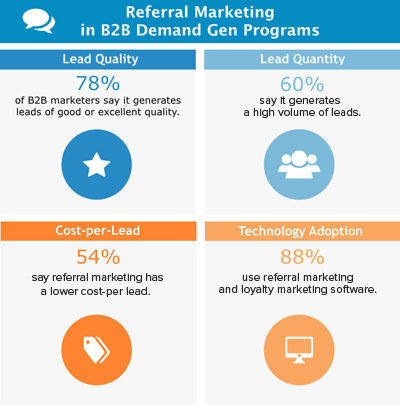
(Source)
For SaaS marketers, now is the ideal time to take advantage of this underutilized strategy. The sheer variety of promotional channels that characterize modern life – everything from social media to email to instant messaging (the list could go on) – has created a space that’s rich in untapped opportunities.
The Referral Marketing Funnel
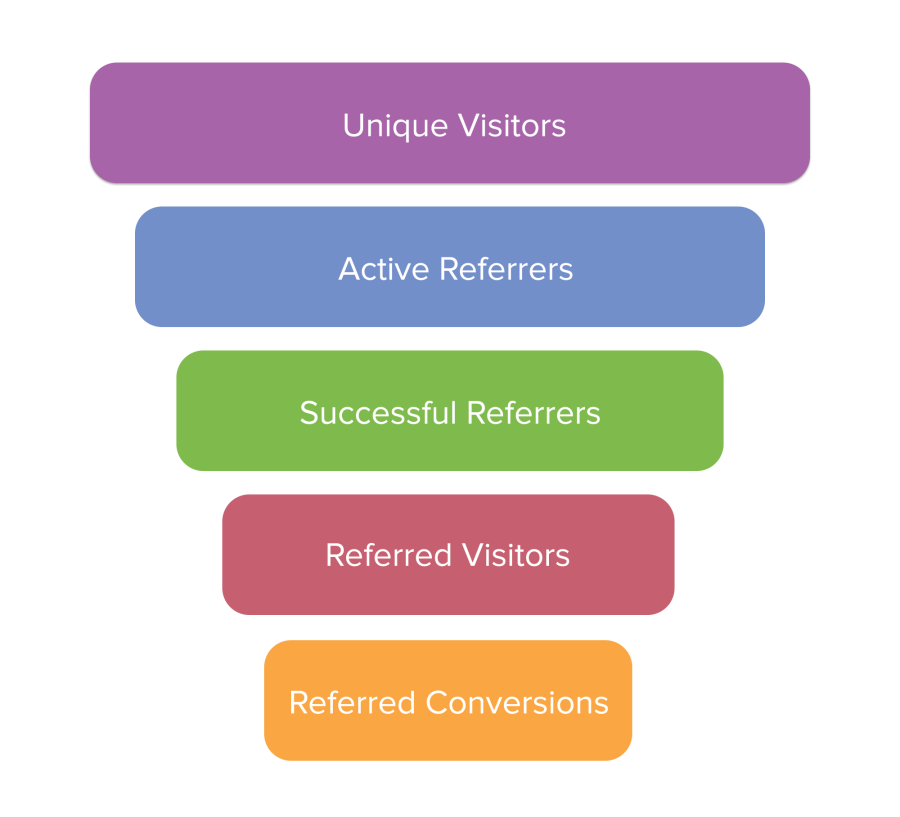
In order to understand how effective referral marketing works, it’s important that we root the “referral funnel” within a broader marketing funnel as pictured above. As you can see from the image, there are five phases of typical funnel that includes referral as a main step. If we were to zoom in on this aspect of the broader funnel, which includes both referrers and “associates” from the point of the first impression to a successful subscription, it’s possible to come up with an entirely new sequence.
- Unique Visitors– This refers to the first stage of customer interaction and indicates how many times your program offer (as opposed to details of the program itself) has been seen.
- Engagement – This is step two, in which established customers actually engage with the program offer.
- Repeat engagement – This is the stage in which customers are encouraged to share more ads with their friends. It may involve a thank you page that highlights another offer or further discounts.
- Sharing – This is the stage in which customers (or “advocates) share your program.
- Friend Impressions – This is the phase in which friends see the ad for your service, as recommended by your customer.
- Friend Engagement– This is the point at which a friend clicks through to your landing page.
- Conversions – “Conversions” signifies an actual purchase of the product or service.
Broadly speaking, all of these steps can be grouped into three distinct stages. We’re going to take a look at each of these in depth, but here’s a brief overview of the SaaS referral marketing funnel:
- Program discovery – program discovery involves all of the stages where a customer is provided with the first potential point of contact with your referral program. This includes, but is not limited to, seeing an advertisement, an in-app button or a social media announcement.
- Program sharing – This stage involves actual interaction on behalf of the customer with your program. It is the point at which a customer learns about the details of your program and decides whether or not to recommend your product. Is it vital that you structure the sharing process at this stage in such a way as to appeal to your customers’ motivations.
- Friend onboarding – This stage covers all of the individual steps from the moment a friend sees a referral ad to the point where they themselves become (ideally) an advocate for your company.
So let’s have a look at each in turn…
Part 1: Program Discovery
It’s worth rooting program discovery in the context of “everyday sharing”, which refers to the way that people tend to share and talk about the things that they like on a normal, everyday basis. The point is that most sharing tends to be a “low-friction” activity. Talking about a movie that you liked or a new app that you’re using requires hardly any effort. This is what lies at the crux of the kind of sharing you want to encourage. To lay the groundwork for low-friction sharing, it’s important to market your referral program to customers at all touch-points.
Dropbox, who are one of the most commonly-cited referral marketing success stories, placed advertisements (with strong CTAs) for their referral program across all of the access points to their company. This included in emails, in their apps, on all of their social media accounts and on their desktop website.
You can see from their website advertisement below that Dropbox make it very easy for customers to invite friends. Users are far more likely to undertake a low-investment activity like giving a friend’s email when the benefits are clearly stated.
The key point to bear in mind here is that you want to include referral prompts at all points of interaction between your company and your users. These include:
- In-app – Both desktop apps and apps designed for handheld devices like mobile phones and tablets. Time spent on mobile devices is increasing, particularly amongst business executives, so it’s important that marketers pick up on this trend.
- In emails – Obviously it’s important to send out promotional materials, but you also want to make sure that you’re including a reference to your referral program in all of your emails, no matter what the topic.
- Across social media – Regularly talking about your program on social media will widen the net to include those customers that may not have taken up other offers.
- On your website – Much of your current client-base will use your website on a regular basis, most often to read new blog posts or consult instructions. Make sure they’re seeing information about your referral program whenever they do.
Also worth talking about briefly are some of the principles that should underlie the way you design your referral program ads. In particular, keep some of the following pointers in mind:
- Clearly communicate the reward – It goes without saying that you should clearly and simply state the benefit you offer in exchange for sharing. But it’s also worth thinking about how you can communicate your incentive when you don’t have a big advertising space to utilize. Clothes retailer American Giant links to their referral program with the text “Get $ 15” rather than a bland alternative.
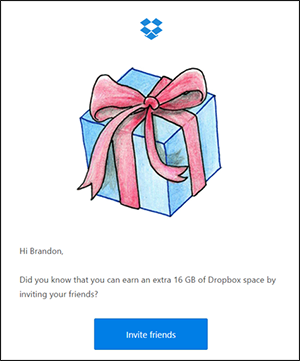
(Source)
- Put a referral CTA on your main app login page – Particularly if your software is browser-based, all of your active clients will pass through the login page of your website. By tactfully placing a CTA on this page you can take advantage of this high flow of traffic.
- Include a CTA on every page of your app – If you look at the example below from Typeform, you will see that they include a small heart button in the right-hand corner of every page of their app. This links through to another landing page that allows users to refer their friends and colleagues. What’s also cool about Typeform’s approach is that it allows you to track how many referrals you’ve made…and thus how many rewards you’ve earned.
Part 2: Program Sharing
Ok, so with the first stage in the referral marketing funnel out of the way, let’s have a look at the second stage. This involves the actual recommendation of your SaaS offering by your customers to their friends. On the surface, this step may seem simple, but it’s important that you streamline the process as much as possible to minimise “drop-off”. You’ll also want to make sure that you are appealing to different customer motivations if you want to achieve the full sharing capacity of your user base.
The importance of making referral sharing a low-friction activity has already been touched upon. Even so, I’ll say it again: it’s absolutely vital that you make sure the process that your current customers need to go through to recommend your product is as easy and seamless as possible.
First, let’s have a look at exactly how you can reduce the “friction” of your referral process…
How to create an effortless sharing process
Designing your referral process to involve as little effort as possible can dramatically increase the success of your program. When you consider that only 29% of consumers refer after a positive experience whilst 89% are actually willing to, it becomes all the more important to streamline this stage in the referral funnel. Human beings thirst for instant gratification and the rise of low-friction features like one-click ordering and instant sign-ups through social media integration all over the web are testament to this fact.
With this in mind, it’s important that you remove as many obstacles to sharing as possible. Don’t make your clients input their email address, or create a new account, or fill out a lengthy form – just popping in an email and clicking send should be the main steps. VPN provider Unblock-US, for example, have a very simple, low-friction referral page
Keep some of the following tips in mind for designing a low-friction sharing experience:
- Provide options – Whilst a fluid process will increase the number of people sharing your service, it’s not always ideal for converting prospective customers. Ideally, you want your current customers to include a personalised message, a picture and even tailor your offer to the specific needs of their friends or colleagues. So whilst the baseline should be low-friction, make sure to include other options for your customers to choose if they wish to.
- Load your referral form on the same page as your CTA – Studies have shown that loading your referral form, including promo codes, on the same page as the CTA can increase conversions.
- Offer instant gratification – Wherever possible offer some kind of reward straight away, or at least as soon as is feasibly possible.
- Let customers know they’ve been successful – Include a notification, again preferably on the same page, that lets your customers now they’ve been successful in recommending your service.
- Reward customers responsible for a high amount of referrals – It’s likely that the bulk of your referrals will come from a small handful of customers. This group is is the main driving force behind your referral engine and it’s important that you reward them to ensure they remain active.
Appealing to different customer motivations
The reasons that motivate people to share are relatively simple and well-understood. In his highly-regarded book Contagious, Wharton Professor Jonah Berger outlines the six attributes of any product, service or set of promotional materials that encourage people to share them.
In the context of your own referral program, it’s important that you approach design with a knowledge of your customer base in mind. This will allow you to tailor each of the six attributes (outlined below) to best speak to their personalities and motivations.
The way that you structure your referral program promotional materials should take into account all of the six “steps” outlined above. In particular, you might find it beneficial to tend towards one of the following:
- Social currency – What positive qualities possessed by your customer does the act of sharing your service highlight? This is a really important one. You want to make sure that part of your advertising describes how your customers will be perceived by sharing, in a way that fits with their values and motivations.
- Emotion – If your audience is particularly ethically-minded or affiliated with any broader social initiatives, tailor your advertising to emphasise the benefits of your service in this regard.
- Practical value – For many SaaS companies, their main selling point is the practical value of their service. Many people will share based on the desire to extend this value to friends and colleagues. Offering the chance to share a discount is a great way of tying into this share trigger, as evidenced by social media automation company Postcron below.
- Stories – We all have a tendency to share stories that we like, so make sure your advertising includes elements of your “company narrative”, particularly if you think that this is one of the main draws of your company.
Once you’ve persuaded your customers to take the plunge, it’s time to focus on the final stage. This involves persuading referral leads to try out your product whilst also setting up the early stages of their customer journey so that it maximises the chances that they too will become advocates for your SaaS company.
Step 3: Friend Onboarding
Word-of-mouth advertising is one of the most effective forms of promotion, particularly when seen in the context of poor metrics about other types of online marketing. Ad blindness, for instance, is an at all time high, whilst social media marketing is growing increasingly difficult as platforms become over-saturated with marketers.
Because referral marketing’s power comes from the fact that it monopolizes on word-of-mouth, utilizing direct recommendations from the friends and colleagues of a potential customer, it’s important that you stress this “personal” aspect.
The more you can get your current users to personalize their recommendations, the higher your conversion rate will climb. Consider some of the following ways to bolster this personalised aspect:
- Include pictures on referral messages – Design referral messages (that is the message sent by your current customer to the person they are recommending your service to) so that they include a picture of the prospective customer’s friend.
- Ask referrers to include a personal message – Where possible, encourage referring customers to include a personal message to their friends. When done in conjunction with effective copy this will further emphasise the fact that your service’s recommendation is genuine. You want to make sure that you include this as an option in the referral process so as to maintain a low degree of friction.
- Allow customers to tailor your advertisements – It’s pretty likely that your customers will know their own network and what drives the individuals in it better than you. If possible, allow customers to tailor promotional materials so that they can appeal directly to unique desires and pain points. This, in a sense, is what eCommerce stores do when they offer the option of specific product recommendations.
- Advertise your referral program immediately – This might seem obvious but you want to start advertising your referral program to prospective customers as soon as possible. You want to “train” people to share and refer from the start of your relationship.
Funnel optimization is the key to success
With the understanding that funnel optimization is the real key to referral marketing success, let’s have a look at some of the key metrics that you should be monitoring, and how they relate to each stage of the broader funnel.
Important benchmarks to be aware of
Here’s a brief rundown of how figures related specifically to your referral marketing funnel tie in with broader SaaS metrics. Working with the funnel described, we can come up with some key metrics. The idea is to use the tactics that have been outlined above to improve all of these metrics.
- Participation rate – The average number of people that recommend your service when given the opportunity to do so (when confronted with a referral program landing page as opposed to ads or a CTA button).
- Referral rate – The total number of referrals (not referrals per customer) that are being made.
- Impression rate – The number of “friends” that engage with your ad. If you are simply raising awareness this will simply be measured in terms of ad views as opposed to clicks.
- Response rate- The number of people that actually sign up to your service in the form of a preliminary offer such as a free trial.
- Conversion rate – The actual number of “friends” that convert into customers.
Conclusion
Referral marketing has the potential be a huge traction channel for your SaaS company. Implementation can be easily achieved through a variety of third-party tools like SaaSquatch, and results can be tracked almost instantly.
This, of course, ties in with a point that hasn’t really been mentioned in the article: the importance of testing. In the search for your own high-growth traction channel, it’s key that you maintain an approach that is predicated on the testing and evaluation of different methods.
In our experience (and as demonstrated by the examples above), referral marketing can be a highly effective, not to mention inexpensive, form of customer acquisition. Yet that doesn’t mean it’s right for everybody. The only way to find out is to take tools in this guide and begin tweaking and testing your own program.
Download this guide as a PDF and share it with your team!
Business & Finance Articles on Business 2 CommunityThis article originally appeared on Referral SaaSquatch and has been republished with permission.
Find out how to syndicate your content with Business 2 Community.
(93)

